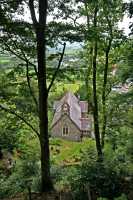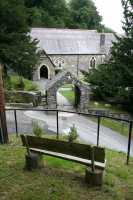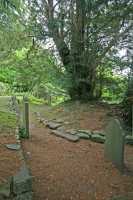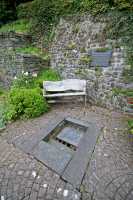History
Llanfihangel Genau’r Glyn is steeped in over two thousand years of history.Below you will find a list of some of the historic features of the area, and Treftadaeth Llandre Heritage local history projects. More details about these features and projects will appear in due course on the relevant links on this page.
You can find more information about the history of the area and the church in books by Randall Enoch OBE, one of the founders of Treftadaeth Llandre Heritage: Llanfihangel Genau’r Glyn – A Church History (2002) and Llanfihangel Genau’r Glyn – The History of a Community (2010). These books were published with the assistance of Treftadaeth Llandre Heritage. Please contact us if you would like to purchase copies of these books.
The distant past
Three ancient forts – Pwll Glas, Llety Llwyd and Allt Goch – are in the immediate vicinity of the village, and a copper axe head from the bronze age was found nearby at Rhydypennau Bridge. Sarn Helen, the Roman road leading northwards from Aberystwyth, passed by not far from the village.
St Michael’s Church
The current parish church building is the third built on the site and dates from 1875. The original church may date from as far back as the Norman period. To find out more about the active life of the church, visit the church website HERE.The ancient yew in the churchyard, together with the holy well below the Church, suggests that the site was sacred before the advent of Christianity. St Michael’s church is one of the destinations for the Peaceful Places trail. More details for the church can be found on Coflein (the Royal Commission on Ancient and Historical Monuments in Wales) .
Lychgate
The lychgate dates from the eighteenth century, and is a rare example of a pre-nineteenth century lychgate over a stream. The portal was restored in the 1990s. The record for the lychgate on Coflein (the Royal Commission on Ancient and Historical Monuments in Wales) is HERE.
Ancient yew tree
The ancient yew tree in the churchyard is two thousand years old, and is one of the oldest trees in West Wales. The yew appears to be three different trees but they spring from a single trunk under the ground; the result of being hit by lightning in the middle ages.
Graveyards
There are three graveyards in the village, the atmospheric old churchyard on the wooded slope overlooking the church and the new churchyard below the road, along with the graveyard for Y Garn Presbyterian Church at Bow Street. You can search a database of the baptism, marriage and death records of the parish church, along the inscriptions of the gravestones in both churchyards, on this website.
Holy well
There is a holy well below the southern wall of the church. The water in the well – which never runs dry – is said to cure rheumatism, and in the nineteenth century trips would be arranged to visit it. The record for the well on Coflein (the Royal Commission on Ancient and Historical Monuments in Wales) is HERE.
Castell Gwallter
On the hill above the village is the site of Castell Gwallter, a motte-and-bailey castle built by the Norman Knight Walter de Bec between 1110 and 1136. The castle was destroyed by the Welsh in 1153. Llanfihangel Castell Gwallter was the name of the parish in the middle ages and a communion cup dated 1573 in the church has this name carved on it. The record of the castle on Coflein (the Royal Commission on Ancient and Historical Monuments in Wales) is HERE.
Glanfrêd Farmhouse
Glanfrêd farmhouse was the site of the family home of Bridget Pryse, mother of Edward Lhuyd, the famous naturalist, antiquarian and scholar who was key in establishing the Ashmolean Museum in Oxford. It is possible that the name was derived from the name of the St Brigid's (Santes Ffraid in Welsh). One of the area’s folk tales hints at a struggle between followers of the sects of St. Michael and St. Brigid here. According to tradition, the church was due to be erected on the site of Glanfrêd but every morning, when the builders return to the site, they would find the walls had been demolished and a mysterious voice heard in the area declaiming: Llanfihangel, yng ngenau’r glyn, Glanfrêd Fawr gaiff fod fan hyn. (St. Michael’s church, in the mouth of the vale, but Glanfrêd Fawr will stand here.)
Ysgoldy Bethlehem
Ysgoldy Bethlehem, the schoolroom for Y Garn Prestyberian Church in Bow Street, was built in 1875 and rebuilt in 1905. It is now a centre for all kinds of community activities as well as a place of worship. The record for Bethlehem on Coflein (the Royal Commission on Ancient and Historical Monuments in Wales) is HERE.
The Hafan tramway and the mainline railway
Llandre was where the Hafan tramway joined the main railway line to Aberystwyth. The tramway transported ore from the hill mines down to the railway. There was a railway station in the village until the Beeching’s axe fell in the 1960s. The station itself is now a private home, and the site of the works associated with the station is now a lovely park and playground for children. The record for the station on Coflein (the Royal Commission on Ancient and Historical Monuments in Wales) is HERE.
Oral history
Treftadaeth Llandre Heritage has conducted an oral history project under the guidance of Llinos Dafis. Information on this project can be found by following the appropriate link from this page.
Education
Education was provided in a Charity School from about 1740, funded by various benefactors and legacies. Shortly afterwards, local education was supplemented by the Circulating Schools of Griffith Jones, with 245 parishioners reportedly attending during 1765. In 1806 a new Church Grammar School was set up as a free school for the children - although only boys are recorded as attending during the early years. Many scholars went on to Oxford and became successful leaders.
Culture
In terms of cultural history, Llandre has had associations with a number of interesting figures. One of the most prominent was J.J.Williams, Archdruid of Wales and author of a poem in praise of Llanfihangel Genau'r Glyn. Dewi Morgan (whose son, Elystan Morgan rose to the House of Lords) was also a very talented poet who won the Chair at the Pwllheli National Eisteddfod in 1925. His contemporaries included J.T. Rees, a gifted composer, and Tom MacDonald, author of White Lanes of Summer. The name of the local papur bro, Y Tincer, was inspired by this work.






